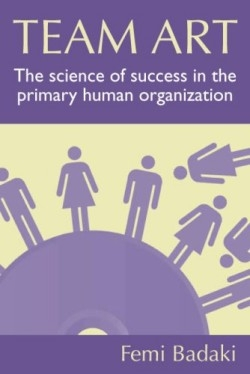Team Art
The Science of Success in the Primary Human Organization
The oft-quoted line by John Donne “No man is an island” especially holds true in a business setting. No matter the size the industry the level of success or the management style every business is made up of one or more teams large or small collections of people with the same ultimate goal.
Femi Badaki focuses on teams in his book Team Art: The Science of Success in the Primary Human Organization. Drawing on his extensive experience in human resources within organizations such as the World Bank and the International Institute of Tropical Agriculture Badaki has produced an exploration of what teams consist of and how to most effectively build assess and manage one.
One refreshing aspect about Badaki’s theory of teams is his premise that natural talents play as large a role in an employee’s success at his or her job as knowledge and learned traits. He writes: “What should be obvious to the discerning student of this emerging discipline is the increasing recognition that we need more than learned skills and knowledge to fully appreciate and utilize the potential of human beings in the workplace.” Toward this end he suggests that team leaders take into account a potential employee’s innate abilities such as adaptability or contagious enthusiasm when hiring individuals for the team. Badaki also recommends programs like the Clifton StrengthsFinder instrument which measures an interviewee’s natural qualities for aid in the hiring process.
Badaki’s greatest strength lies in his ability to provide a clear definition of teams. While many readers might assume they understand what a team is Badaki further illuminates the exact nature of a team by discussing self-awareness missions visions work roles team leaders functional reviews and many other aspects of teams an organization may take for granted. Under his guidance teams may be seen as organic systems which grow evolve and die according to a natural arch.
While Badaki concentrates on occupational teams he also reminds readers that teams are everywhere: in sports families households and communities. Many of his discussions such as his theory on personal values and the discrepancy between what people say they value and what they actually value have implications beyond the office. His focus remains business-centered however and his language within the book reflects that focus. Sentences and phrases are fairly academic and occasionally lapse into cliché though not to the detriment of the message. Badaki provides diagrams charts and chapter-end summaries that add clarity to his discussion and includes two appendices and an index.
More than a manual Team Art is an invitation to join another kind of team one that works toward making business function at a more productive level healthier for both the company and the employees. Badaki has obviously invested a great deal of thought in his discussion of teams and his readers will reap the benefits of his many years of experience.
Reviewed by
Andi Diehn
Disclosure: This article is not an endorsement, but a review. The publisher of this book provided free copies of the book and paid a small fee to have their book reviewed by a professional reviewer. Foreword Reviews and Clarion Reviews make no guarantee that the publisher will receive a positive review. Foreword Magazine, Inc. is disclosing this in accordance with the Federal Trade Commission’s 16 CFR, Part 255.

